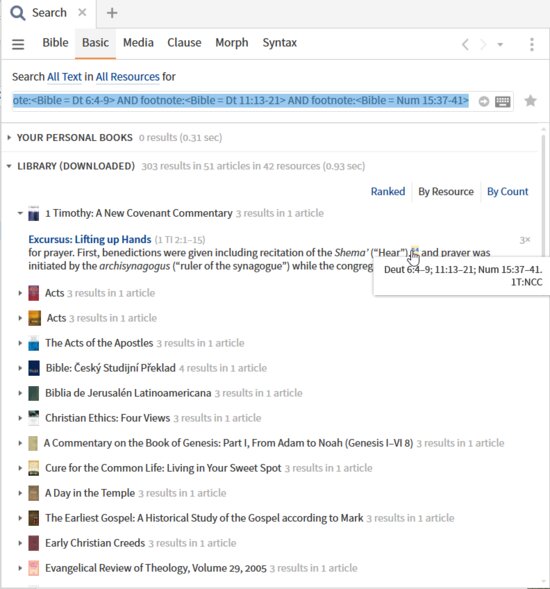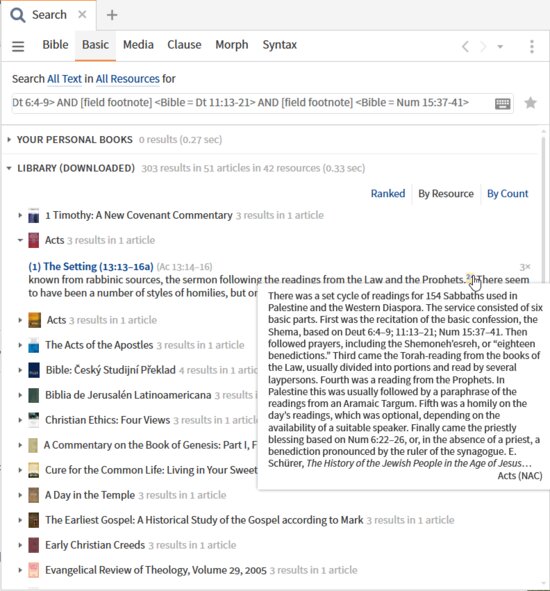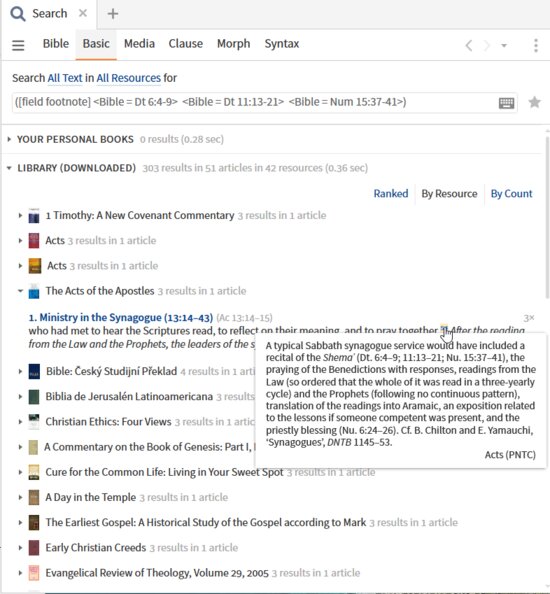Docx files for personal book: Verbum 9 part 1; Verbum 9 part 2; Verbum 9 part 3; Verbum 9 part 4; Verbum 9 part 5; How to use the Verbum Lectionary and Missal; Verbum 8 tips 1-30; Verbum 8 tips 31-49
Reading lists: Catholic Bible Interpretation
Please be generous with your additional details, corrections, suggestions, and other feedback. This is being built in a .docx file for a PBB which will be shared periodically.
Previous post: Verbum Tip 7p Next post: Verbum Tip 7r
Term modifier: search field
From Verbum Help:
[quote]Search Fields
Search fields are just names applied to certain special areas of resources that have been marked so they can be searched exclusively. For example, in Bibles, all of the actual biblical text exclusive of headings, footnotes, indicators, and so on is said to be in the bible field.
Fields are applied to terms in two ways:
• fieldName1,fieldName2:term — One or more fields joined by commas (without spaces) prefixed to the term with a colon
• ([field fieldName1, fieldName2] term) — One or more fields joined by commas in square brackets [field ...]
The first, shorter method can be applied to any single term.
bible:people in a book that supports the bible field will match “people” only in the Bible text proper.
bible,red:people or bible,woc:people matches “people” only in Bible text and red-lettered text (woc is short for “Words of Christ”).
footnote:<Bible = Jn 3:16> finds exact references to John 3:16 in footnote text.
The second, more verbose, method is useful for applying fields to multiple terms at once.
[field footnote] justification sanctification <Bible Romans 5-7> is equivalent to footnote:justification footnote:sanctification footnote:<Bible Romans 5-7>.
This notation may appear when switching between search types, such as switching from Bible Search or Morph Search to Basic Search:
([field bible, content] <Lemma = lbs/el/λόγος>)
This means that the Lemma data type reference should only be matched in the bible or content fields.
Resources support many different search fields. To find out what search fields a given resource supports:
1. Open the resource.
2. Open the Panel menu in the top-right corner of the resource. (Or press Ctrl+I / Cmd+I).
3. Click Information.
4. Search fields available in the resource will be listed under the heading <~Search Fields> near the bottom of the resource information.
Take the spaces out of a field’s name to search with it. For example, if Heading Text is supported by the resource, type HeadingText: into the search query.
Choose search fields from the <~All Text> search parameter at the top of the Search panel.[1]
Search fields deemed common enough to include in Verbum Help:
[quote]Search Fields
Limit a search by particular search text that is marked with one of these fields by adding one of these field names before the search term with a colon. (E.g. author:Newman only finds the search term "Newman" when it is in text marked with the “Author” field.)
• abbreviated — Morphology specifies use of an abbreviated form (used only with various numerals).
• abbrevpop — The text of the pop-up indicator for an abbreviation, and the text of the abbreviation pop-up itself.
• add — Text denoted by a symbol indicating insertions.
• addmean — Additional phases of meaning included in the original word, phrase, or clause of the original language.
• addtext — Is either familiar passages not adequately supported by the original manuscripts or words not appearing in the original language added to connect meaning for English readers.
• aeolic — Morphology specifies use of the Aeolic dialect.
• ambiguous — Ambiguous morphological form of a word. Ambiguous form implies no preferred form for the current word.
• apocopated — Morphology specifies use of an apocopated form.
• apparatus — Entries from the textual apparatus and the segmentation apparatus.
• appindic — The text of an apparatus indicator, and the apparatus note itself if that note is a popup.
• artauthor — The author of an article or review, rather than the author of a work under review.
• attic — Morphology specifies use of the Attic dialect.
• author — Authors cited or discussed.
• base — Stem form.
• bhsform — The text of the Hebrew Bible as written in the Biblia Hebraica Stuttgartensia (when it differs from the text to be read).
• bible — The actual text of the Bible verses, without introductions, headings, etc.
• bull — Text denoted by a symbol indicating orthographic (spelling) variants.
• chufat — Church Fathers.
• citation — Citation.
• city — A city name.
• clrfywrds — Justified clarifying words or comments not actually expressed in the immediate original text, as well as definitions of Hebrew and Greek names.
• code-example — Examples of program code, typically occurring in documentation resources.
• collection — Collection title.
• colon — Text indicating variant punctuation.
• color — Liturgical color.
• comment — Descriptions and comments concerning the translated manuscript or inscription.
• content — The text of the original content of this resource, without headings, translators’ notes, etc.
• contributor — A contributor to a song, such as the lyricist or composer.
• copyright — Copyright information for an image or media element.
• crasis — Morphological form when two words merge together to form a crasis or conjunction.
• credit — Credit information for an image or media element.
• crossref — The text of the pop-up indicator for a cross-reference, and the text of the reference itself.
• date — A calendar date.
• dateofpub — Date published.
• day — The title of a day, such as a Sunday or feast day, in a liturgical calendar.
• description — The description of an object, usually an image or media element.
• dewey — Dewey Decimal Number.
• disputed-passage — Text that is disputed, especially concerning its authenticity or its inclusion a particular corpus.
• dynasty — The dynasty in which the manuscript or inscription was composed.
• earlyver — Early versions.
• editions — Editions.
• editor — Editor.
• emend — The word or words are a textual emendation.
• etymology — Descriptions of the linguistic history and development of a particular word or phrase.
• extdef — Extended definition of a given lemma.
• fath — Church Fathers.
• footnote — Text that appears in a footnote.
• form — Manuscript form of an interlinear word.
• formeq — A formal equivalent or gloss of a given lemma.
• generalnote — The text of the pop-up indicator for a note, and the text of the note itself.
• gloss — In a dictionary of lexicon, a brief explanation or definition of a word or phrase.
• heading — The text of book, chapter, and pericope headings.
• headtitle — The text of book, chapter and pericope headings.
• id — The ID of a song in a collection.
• inflected — Inflected form.
• inv — In volume.
• irregular — Morphology specifies use of an irregular form.
• isbn — ISBN Number.
• issn — ISSN Number.
• ketiv — The text of the Hebrew Bible that is written when it differs from the text to be read.
• language — Language.
• largetext — Allows search of headings and such.
• later-addition — Text that is considered to be a later addition to earlier manuscripts.
• latin — Latin manuscript.
• lect — Lectionary manuscript.
• lectionaries — Lectionaries.
• lemma — Text that appears in its dictionary form.
• lexeme — Lexical form.
• lexval — Translation of a lexical form of a word.
• literal — Literal translation of an ancient language word or phrase.
• livre — Publication title.
• livretype — Publication type.
• lmanu — Latin manuscript.
• location — The location of the manuscript or inscription.
• lxx — Text of the Septuagint Greek Old Testament.
• lyrics — The lyrics of a song.
• mainline — The reading selected by the editors as the main line in places where variant readings exist.
• middle-significance — Morphology specifies use of a form with middle significance.
• mini — Miniscule manuscript.
• miniscules — Miniscules.
• modernized — Modernized spellings of the original text.
• modlang — Modern language translation of the Greek New Testament cited in Discourse Segmentation Apparatus.
• morphcode — Morphological code derived from the SEDRA 3 database.
• mscule — Miniscule manuscript.
• mt — Masoretic Text of the Hebrew Old Testament.
• negapp — Apparatus entries with readings that vary from the text proper.
• nothing — Text that is purely informational and does not contain an apparatus indicator as such.
• omit — Text denoted by symbols indicating omissions, either single words or groups of words.
• original — John Knox’s original text, as spelled in eighteenth-century Scottish.
• ot-quote — Text from the Old Testament Bible quoted in the New Testament.
• pages — Pages.
• papy — Papyrus manuscript.
• paralleltitle — Parallel title.
• part-of-speech — Grammatical part of speech designation for a dictionary of lexicon headword.
• particle-attached — Morphology specifies use of a form with a particle attached (with relative pronoun).
• periodical — Periodical title.
• pernote — Text that appears in a pericope note.
• pmt — The primary morphological tag for a given word.
• possapp — Apparatus entries that support the reading found in the text proper.
• primary-reading — Tischendorf’s Primary Reading.
• pronunciation — Text which details the exact phonetic pronunciation of a particular word or phrase.
• prosody — Prosodial remarks.
• qere — The text of the Hebrew Bible that is to be read when it differs from the text that was written.
• ran — Text denoted by symbols indicating replacements (being either single words or groups of words).
• rauthor — The author of a review rather than the author of the work under review.
• reading — A Scripture reading in a lectionary.
• reconst — Theoretical reconstruction of the Hebrew source document for the Septuagint Greek Old Testament.
• reflex — Inflected form of a given word associated with its lemma for lookup purposes.
• region — A country or tribal area or some other generic geographic region.
• review — The title of the work under review.
• root — The root form.
• rtitle — The title of the work under review.
• season — A liturgical season such as Advent or Easter.
• standards — Text that should be interpreted as a standard to be followed. (E.g. a markup standard or a visual standard)
• subtitle — Subtitle.
• supp — The word or words are supplied for sake of clearness.
• surface — Text that is visible using default view settings; in interlinears, the top line using default view settings.
• tag — Tags for an image or media element.
• title — The title of an object, usually an image or media element.
• topic — Topics.
• topiclevel — Topic level.
• totalpages — Total number of pages.
• trans — Text denoted by symbols indicating transpositions.
• transeq — Suggested translation equivalent of a Greek quotation.
• transitive — Morphology specifies use of a transitive form.
• translation — Listings of how an ancient language word is translated in other documents.
• transnote — The text of the pop-up indicator for a translator’s note, and the text of the note itself.
• tune — The tune of a song.
• txt — The list of witnesses supporting the text of this edition. It always occurs as the last member of a group of readings or variation unit.
• uncial — Uncial manuscript.
• uncials — Uncials.
• used-as — Instances where a morphological form is being used for a different function than the actual form. (E.g. nominative “used as” vocative)
• variant — Variant morphological form of a word.
• varline — A variant reading.
• varunit — A unit that is treated as a variation unit within the apparatus.
• ver — Early versions.
• versions — Version.
• words-of-christ — Text considered to be the words of Christ, traditionally the “red-letter” text.
• xrefs — Cross references.
• year — Lectionary year. [2]
Requests for modification generated for the search field:
Note that there are additional search fields that are available in the clause search.
Search for the Shema in footnotes: footnote:<Bible = Dt 6:4-9> AND footnote:<Bible = Dt 11:13-21> AND footnote:<Bible = Num 15:37-41>

Or one can use the long form: [field footnote] <Bible = Dt 6:4-9> AND [field footnote] <Bible = Dt 11:13-21> AND [field footnote] <Bible = Num 15:37-41>

Or in the compact form ([field footnote] <Bible = Dt 6:4-9> <Bible = Dt 11:13-21> <Bible = Num 15:37-41>)

[1] Verbum Help (Bellingham, WA: Faithlife, 2018).
[2] Verbum Help (Bellingham, WA: Faithlife, 2018).